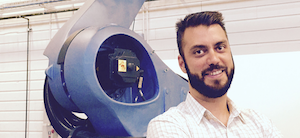Guvenc Ozel Wins NASA Prize for Mars Habitat Design

#36 - Guvenc Ozel, 35 - Architect
His work is at the intersection of architecture, technology, media and research on urban culture. A native of Turkey, Özel studied architecture, sculpture, and philosophy at Bennington College. In addition, he holds a Master’s of Architecture degree from Yale University, where he graduated with multiple awards. Prior to establishing his own practice and research, he worked in the architecture offices of Rafael Vinoly, Jürgen Mayer H. and Frank Gehry, amongst others. His projects and experimental installations were exhibited in museums and galleries in the USA and Europe such as the Istanbul Museum of Modern Art and The Saatchi Gallery in London.
He formerly taught at Yale University, Woodbury University and the University of Applied Arts in Vienna. His recent work has been heavily published in online, broadcast and print media such as CNN, BBC, The Los Angeles Times, Wired, The Boston Globe, Architectural Digest, Gizmodo, Creators Project/ Vice, Dwell, Designboom, among others. At UCLA IDEAS, besides teaching his own master’s design studio alongside industry luminaries Greg Lynn, Thom Mayne and Frank Gehry, he continues his research on 3D printing, computation, virtual reality, robotics, interactive spaces and sensing interfaces with support from leading design software company Autodesk.
Recently Özel was awarded fourth prize in NASA’s 3-D Printed Habitat Challenge. The competition called for architectural concepts for a four-astronaut dwelling on Mars that could be 3-D printed through the use of resources indigenous to the Red Planet. NASA received more than 165 entries in the competition, which is ultimately aimed at contributing towards the development of new technologies for additive manufacturing using "local indigenous materials" in space and on Earth.
He formerly taught at Yale University, Woodbury University and the University of Applied Arts in Vienna. His recent work has been heavily published in online, broadcast and print media such as CNN, BBC, The Los Angeles Times, Wired, The Boston Globe, Architectural Digest, Gizmodo, Creators Project/ Vice, Dwell, Designboom, among others. At UCLA IDEAS, besides teaching his own master’s design studio alongside industry luminaries Greg Lynn, Thom Mayne and Frank Gehry, he continues his research on 3D printing, computation, virtual reality, robotics, interactive spaces and sensing interfaces with support from leading design software company Autodesk.
Recently Özel was awarded fourth prize in NASA’s 3-D Printed Habitat Challenge. The competition called for architectural concepts for a four-astronaut dwelling on Mars that could be 3-D printed through the use of resources indigenous to the Red Planet. NASA received more than 165 entries in the competition, which is ultimately aimed at contributing towards the development of new technologies for additive manufacturing using "local indigenous materials" in space and on Earth.
Last modified onSaturday, 06 May 2017 10:07
Latest from Admin TOA
- The Young Star of the Gastronomy World Is The New Owner of Samdan
- From Dream to Reality, from Muş to Illinois: Zellano Home, the Largest Furniture Store Under One Roof in the USA!
- 300 migrants to be housed at shuttered Catholic church on Northwest Side in Chicago
- Turkish Philanthropy Funds Hosts 2024 Innovation and Social Impact Summit
- Turkish Stand-Up Sensation Hasan Can Kaya Embarks on U.S. Tour with Art Evi Production, in212 Production, and TAAS New York
